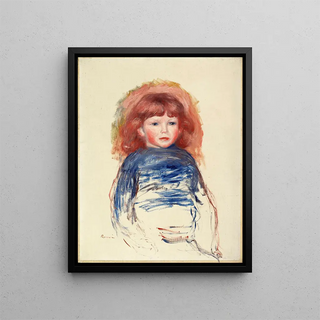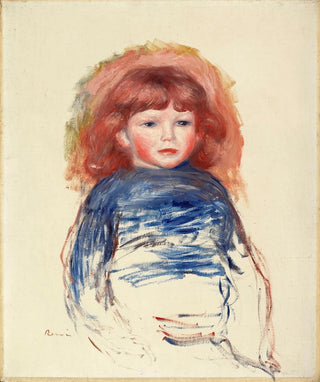Art print | Coco - Pierre-Auguste Renoir


View from behind

Frame (optional)
Coco Art print - Pierre-Auguste Renoir – Captivating Introduction
The "Coco" art print by Pierre-Auguste Renoir is a piece that captures the very essence of childhood and innocence. Created in 1910, this canvas embodies Renoir's unmatched talent for seizing moments of tenderness and beauty. The artwork features a young girl, affectionately named Coco, who is actually the artist's daughter. Through this portrait, Renoir does not merely depict his model; he captures an emotion, an atmosphere, a story. The delicate light caressing the child's face, along with the bright and harmonious colors, transports the viewer into a universe filled with softness and serenity. This piece is much more than a simple representation; it is an invitation to contemplate the beauty of life through the eyes of a child.
Style and uniqueness of the work
Renoir's style is immediately recognizable, and "Coco" is no exception. The artist, an emblematic figure of the Impressionist movement, has always strived to translate light and color into his works. In "Coco," he uses fluid and light brushstrokes, creating an almost tangible texture that brings the scene to life. The shades of pink and blue, in particular, evoke a joyful and soothing atmosphere. Renoir skillfully plays with light, allowing it to dance across the child's face and illuminate her delicate features. This artwork is also characterized by a balanced composition, where the main subject is highlighted by a blurred and harmonious background. This technique allows the viewer to focus on Coco's innocent expression while being enveloped in a warm ambiance.
The artist and his influence
Pierre-Auguste Renoir, one of the masters of Impressionism, left an indelible mark on art history. Born in 1841, he was initially trained in Charles Gleyre's studio before approaching iconic figures like Monet and Sisley. Renoir always sought to express the beauty of fleeting moments, scenes of everyday life, and vibrant portraits. His influence extends well into

Matte finish

View from behind

Frame (optional)
Coco Art print - Pierre-Auguste Renoir – Captivating Introduction
The "Coco" art print by Pierre-Auguste Renoir is a piece that captures the very essence of childhood and innocence. Created in 1910, this canvas embodies Renoir's unmatched talent for seizing moments of tenderness and beauty. The artwork features a young girl, affectionately named Coco, who is actually the artist's daughter. Through this portrait, Renoir does not merely depict his model; he captures an emotion, an atmosphere, a story. The delicate light caressing the child's face, along with the bright and harmonious colors, transports the viewer into a universe filled with softness and serenity. This piece is much more than a simple representation; it is an invitation to contemplate the beauty of life through the eyes of a child.
Style and uniqueness of the work
Renoir's style is immediately recognizable, and "Coco" is no exception. The artist, an emblematic figure of the Impressionist movement, has always strived to translate light and color into his works. In "Coco," he uses fluid and light brushstrokes, creating an almost tangible texture that brings the scene to life. The shades of pink and blue, in particular, evoke a joyful and soothing atmosphere. Renoir skillfully plays with light, allowing it to dance across the child's face and illuminate her delicate features. This artwork is also characterized by a balanced composition, where the main subject is highlighted by a blurred and harmonious background. This technique allows the viewer to focus on Coco's innocent expression while being enveloped in a warm ambiance.
The artist and his influence
Pierre-Auguste Renoir, one of the masters of Impressionism, left an indelible mark on art history. Born in 1841, he was initially trained in Charles Gleyre's studio before approaching iconic figures like Monet and Sisley. Renoir always sought to express the beauty of fleeting moments, scenes of everyday life, and vibrant portraits. His influence extends well into






